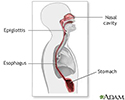Esophageal spasm
Diffuse esophageal spasm; Spasm of the esophagus; Distal esophageal spasm; Nutcracker esophagus
Esophageal spasms are abnormal contractions of the muscles in the esophagus, the tube that carries food from the mouth to the stomach. These spasms do not move food effectively to the stomach.
Causes
The cause of esophageal spasm is unknown. Very hot or very cold foods may trigger spasms in some people.
Symptoms
Symptoms may include:
- Problems swallowing or pain with swallowing
- Pain in the chest or upper abdomen
It can be hard to tell a spasm from angina pectoris, a symptom of heart disease. The pain may spread to the neck, jaw, arms, or back
Exams and Tests
Tests you may need to look for the condition include:
- Esophagogastroduodenoscopy (EGD)
- Esophageal manometry
- Esophagogram (barium swallow x-ray)
Treatment
Nitroglycerin given under the tongue (sublingual) may help a sudden episode of esophageal spasm. Long-acting nitroglycerin and calcium channel blockers are also used for the problem.
Long-term (chronic) cases are sometimes treated with low-dose antidepressants such as trazodone or nortriptyline to reduce symptoms.
Rarely, severe cases may need dilation (widening) of the esophagus or surgery to control symptoms.
Outlook (Prognosis)
An esophageal spasm may come and go (intermittent) or last for a long time (chronic). Medicine can help relieve symptoms.
Possible Complications
The condition may not respond to treatment.
When to Contact a Medical Professional
Contact your health care provider if you have symptoms of esophageal spasm that don't go away. The symptoms may actually be due to heart problems. Your provider can help decide if you need heart tests.
Prevention
Avoid very hot or very cold foods if you get esophageal spasms.
References
Falk GW, Katzka DA. Diseases of the esophagus. In: Goldman L, Schafer AI, eds. Goldman-Cecil Medicine. 26th ed. Philadelphia, PA: Elsevier; 2020:chap 129.
Pandolfino JE, Kahrilas PJ. Esophageal neuromuscular function and motility disorders. In: Feldman M, Friedman LS, Brandt LJ, eds. Sleisenger and Fordtran's Gastrointestinal and Liver Disease. 11th ed. Philadelphia, PA: Elsevier; 2021:chap 44.
Digestive system - illustration
Digestive system
illustration
Throat anatomy - illustration
Throat anatomy
illustration
Esophagus - illustration
Esophagus
illustration
Review Date: 11/3/2022
Reviewed By: Michael M. Phillips, MD, Emeritus Professor of Medicine, The George Washington University School of Medicine, Washington, DC. Also reviewed by David C. Dugdale, MD, Medical Director, Brenda Conaway, Editorial Director, and the A.D.A.M. Editorial team.










